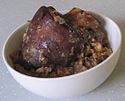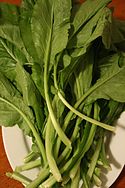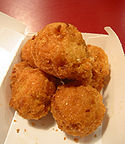Soul food is the ethnic cuisine of African-Americans. It originated in the American South from the cuisines of enslaved Africans trafficked to the North American colonies through the Atlantic slave trade during the Antebellum period and is closely associated (but not to be confused with) with the cuisine of the American South.The expression “soul food” originated in the mid-1960s, when “soul” was a common word used to describe African-American culture.Soul food uses cooking techniques and ingredients from West African, Central African, Western European, and Indigenous cuisine of the Americas. Soul food was a mixture of what African Americans ate in their home countries in Africa and the food available to slaves. Soul food was not without its fair own share of negative aspects at first. It was thought of as a food that was considered low-class and Northern African Americans looked down at them as Black Southern counterparts who favored soul food. It evolved from being the staple diet of slaves within the South to becoming a major source of identity for this African American community in the North like New York City.
Table of Contents
History
Soul food was a staple of the kitchens that was typical of rural Southern United States also known as”the “deep south” and has its roots in slavery made with locally-sourced or raised food items and other ingredients that were inexpensive. Rabbits, squirrels and deer were frequently hunted to harvest meat. Fish, frogs and crabs, turtles, crawfish and crabs were typically harvested from freshwaters as well as salt water and marshes.Soul food was first introduced during slavery, during which Black American/ African American slaves were served leftovers, as well as the unpalatable animal parts including pork jowls, ham hocks and pig’s feet skin, ears, and intestines. These were items that white plantation slaves did not consume. The corn and the pork was the two most popular foods that were consumed in the Southern United States for both slave owners as well as slaves. The owners of slaves could have smoked ham or corn pudding, whereas the slaves were given food items like ofal.
Origins
The phrase Soul Food was popularized in the late 1960s and early 1970s during the Black Power movement. One of the first written references to the term can be found within “Te Autobiography” of Malcolm X, that was published in the year 1965. LeRoi Jones (later identified by the name of Amiri Baraka) wrote an essay titled “Soul Food” and was one of the main advocates of establishing the food culture as an integral part that of Black American identity. People who were part of The Great migration were able to find in soul food a remembrance of their family and home they left behind when leaving for the unfamiliar cities of northern. Soul-food restaurants are owned by Black enterprises that functioned as gathering places for neighborhood residents that allowed people to socialize and dine together.
Soul food recipes are influenced by an influence of slavery as West African and European foods were modified to fit the specific environment in the area. A lot of the food items that are essential to the cuisine originate from the limited food items that the poor farmers of southern subsistence could get their hands on. This was evident in the rations offered to people who were enslaved through their masters. People who were enslaved typically received the equivalent of a portion of cornmeal, and 3-4 pounds of pork a week. These meals formed the basis for African American soul food.
Many enslaved persons had to eat a diet high in calories to replenish their energy levels after doing long hours in fields or completing other physical laborious chores. Because of the close proximity of wealthy owners of slaves to chattel slaves this cooking style was adopted into the wider Southern society, since slaves were the main cooks in plantation homes that despite their wealth typically relied on what was available daily from their farms or share croppers that rented out plantation land.
White and Black people of the South cooked a variety of the same meals derived from this tradition, however the ways of cooking could be different. Certain methods that are popular for soul food and various Southern food styles (i.e. cooking meat in a fryer and utilizing all of the meat from the animal to eat) are common to old-fashioned cultures across the globe which includes those from China, Egypt, and Rome.
The introduction of soul food to cities like Washington, D.C. and Baltimore occurred during the Great Migration as African Americans moved to the North to find work.
Researchers have noticed the significant African influence on soul foods, particularly from the west as well as central areas in Africa. This influence can be observed through the heat levels of a variety of soul food recipes and the many ingredients that are found in them.Peppers that were that were used to spice up food were malagueta peppers along with other varieties that are native of the western part of the hemisphere, such like peppers like red (cayenne) peppers.A variety of food items that are vital to the southern cuisine and soul food were eaten or cultivated in the African Savanna and zones of the tropical region West as well as Central Africa. This includes pigeon peas Okra, black-eyed peas and sorghum.It is believed that sorghum was the first of these.
It is also noted that a variety known as was grown in Africa which is why a lot of Africans who came to the Americas preserved their knowledge about food preparation with rice. Rice is a popular meal throughout food preparation in the Lowcountry area as well as throughout Southern Louisiana. Rice is the main ingredient in dishes like jambalaya and rice and red beans that are very widely consumed and popular in Southern Louisiana.
There are numerous documented connections between the cuisines that are typical of West Africans and soul food recipes. The consumption of sweet potatoes in the US is similar to the yams consumed from West Africa. The consumption of cornbread among African-Americans is similar with West Africans’ use of fufu to suck up stews.
West Africans also cooked meat in open pits, this is why it’s possible that slave Africans were brought to the Americas knowing this method of cooking (it is also possible that they learned this technique by learning it from Native Americans, since Native Americans used barbecues to cook their food).
It was not unusual to find food being served in an empty gourd. A variety of methods for changing the flavor of common foods like seeds, nuts and rice added an increase in the variety of tastes. These methods included roasting making fried using palm oil baking in ashes, roasting and steaming in leaves, such as a leaves of banana leaf.
Southeastern Native American culture is a key component of Southern food. The culture of their people was one of the principal ingredients in the Southern diet that was corn (maize) or grinded into meal or limed with an alkaline salt in order to create hominy, through the Native American process known as nixtamalization.The use of corn was for the preparation of a wide range of foods, from traditional cornbread and grits to spirits like whiskey and moonshine (which are still vital to the Southern economy and are still important to the Southern economy.
A variety of fruit varieties are readily available throughout the region. the blackberries, muscadines, raspberries as well as a myriad of others were a part of Southern Native Americans’ diets and.
African, European, and Native Americans of the American South included in their diets products from the hunt and gathering of indigenous game. The type of meat consumed by the people depended on seasonal availability and geographic region. The most popular game was Opossums, rabbits and squirrels. The idea that involves raising livestock like livestock such as cattle as well as hoggs was inherited by white people who were of European origin.
When livestock or game was killed, the whole animal was consumed. Apart from eating the animal, it was typical for them to consume organ meats like brains, livers and the intestines. The tradition is still present in the most popular dishes, such as Chitterlings (commonly known as Chit’lins) that are the small intestines that a hog eats and livermush (a typical dish of the Carolinas made of hog liver) and eggs and brains of pork. The fat from the animals, especially hogs, was processed and used to cook and cooking and. A lot of early European immigrants to the South took up Native American cooking methods, and thus cultural exchange took place to create food preparation in the Southern dish.
List of soul foods and dishes :
Vegetables and legumes
Beans, greens and other vegetables are often cooked with ham or pork parts to add flavor.









































